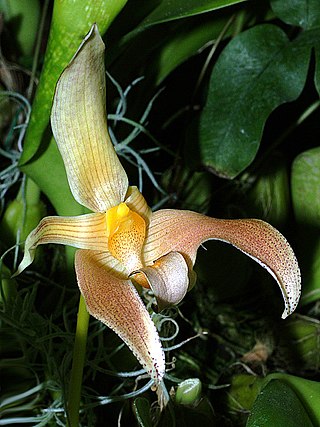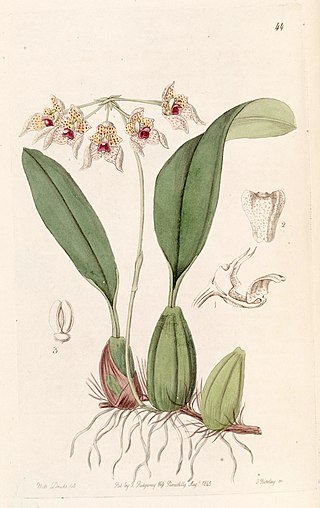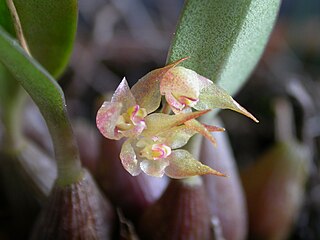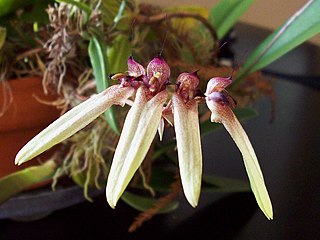
Bulbophyllum is a genus of mostly epiphytic and lithophytic orchids in the family Orchidaceae. It is the largest genus in the orchid family and one of the largest genera of flowering plants with more than 2,000 species, exceeded in number only by Astragalus. These orchids are found in diverse habitats throughout most of the warmer parts of the world including Africa, southern Asia, Latin America, the West Indies, and various islands in the Indian and Pacific Oceans. Orchids in this genus have thread-like or fibrous roots that creep over the surface of trees or rocks or hang from branches. The stem is divided into a rhizome and a pseudobulb, a feature that distinguished this genus from Dendrobium. There is usually only a single leaf at the top of the pseudobulb and from one to many flowers are arranged along an unbranched flowering stem that arises from the base of the pseudobulb. Several attempts have been made to separate Bulbophyllum into smaller genera, but most have not been accepted by the World Checklist of Selected Plant Families.

Johannes Jacobus Smith was a Dutch botanist who, between years 1905 to 1924, crossed the islands of the Dutch East Indies, collecting specimens of plants and describing and cataloguing the flora of these islands. The standard botanical author abbreviation J.J.Sm. is applied to plants described by J.J. Smith.
A semiochemical, from the Greek σημεῖον (semeion), meaning "signal", is a chemical substance or mixture released by an organism that affects the behaviors of other individuals. Semiochemical communication can be divided into two broad classes: communication between individuals of the same species (intraspecific) or communication between different species (interspecific).

Phenanthrenoids are chemical compounds formed with a phenanthrene backbone. These compounds occur naturally in plants, although they can also be synthesized.

Bulbophyllum biflorum is a species of orchid. This species was found in Java, Sumatra, Bali, Borneo, the Philippines, and the Thai and Malaysian peninsula. The flower size is 7.5 cm long.

Bulbophyllum lobbii is a species of orchid, also known as Thailand bulbophyllum or Sumatran bulbophyllum. It was named for the plant hunter Thomas Lobb, who introduced it to England from Java in 1846.

Bulbophyllum umbellatum is a species of orchid. It is native to tropical parts of South Asia, from the west central Himalayas to Taiwan and Indo-China.
Bulbophyllum abbreviatum is a species of orchid in the genus Bulbophyllum discovered in Madagascar and originally described by German botanist Rudolf Schlechter, from material collected by French botanist H. Perrier de la Bâthie in February 1912, which is now kept in the Muséum National d'Histoire Naturelle in Paris.

Bulbophyllum apodum is a species of orchid in the genus Bulbophyllum. It bears a 12–14 cm inflorescence with around 40 small fragrant white flowers on it. It is native to Sikkim, Borneo, China, Malaysia, Thailand, the Philippines, Vanuatu, and Vietnam.
Bulbophyllum minutissimum, commonly known as the red bead orchid or grain-of-wheat orchid, is a species of epiphytic or lithophytic orchid with small, flattened, reddish or green pseudobulbs, scale-like leaves and small whitish to reddish flowers with broad dar red stripes. It grows on trees and rocks, mostly in swamps and near streams in eastern Australia.

Bulbophyllum moniliforme is a species of orchid in the genus Bulbophyllum. It is indigenous to the Assam region in eastern India.

Bulbophyllum ovalifolium is a species of orchid in the genus Bulbophyllum.

Bulbophyllum scabratum or Rough Bulb-Leaf Orchid is a species of orchid in the genus Bulbophyllum in section Eublepharon.
Bulbophyllum unguiculatum is a species of orchid in the genus Bulbophyllum. It is commonly known as the clawed bulbophyllum. It is found in Sumatra, Java, Borneo and Sulawesi in lower montane forests.

Dendrobieae is a tribe in the subfamily Epidendroideae, in the family Orchidaceae. The Dendrobieae are mostly tropical, epiphytic orchids which contain pseudobulbs.
Jaap J. Vermeulen is a Dutch botanist, specializing in the Orchidaceae genus Bulbophyllum.
An attractant is any chemical that attracts an organism, e.g. i) synthetic lures; ii) aggregation and sex pheromones ; and iii) synomone

Bulbophyllum sect. Cirrhopetalum is a section of the genus Bulbophyllum. The taxon name comes from Latin cirrus (fringe) and Greek petalon (petal), hence meaning fringed-petaled.












